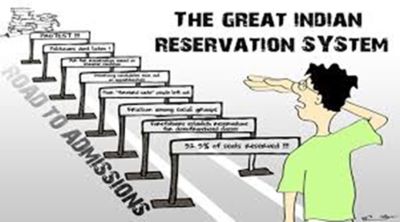Context-
The ongoing debate surrounding sub-caste reservations within India's Scheduled Castes (SC) and Scheduled Tribes (ST) communities has gained renewed attention with the Supreme Court's decision pending. This issue demands a thorough examination not only from legal perspectives but also based on academic and factual justifications.

|
What is Sub- categorizartion of Caste? Sub-classification is the practice of dividing larger caste groups into smaller subgroups. These subgroups are determined based on socioeconomic factors, geographic location, historical background, or specific policy needs. Background of Issue- ● ThePresent case questions whether states have the authority to create sub-classifications within the SC and ST categories. ● In 2004, the Supreme Court ruled against sub-classification in the E. V. Chinnaiah v State of Andhra Pradesh case. The court argued that the SC list should be considered a single, unified group. ● Currently, only the Indian Parliament has the power to sub-classify SCs and STs. ● The case is originated from a 1975 notification by the Punjab government. The notification divided the state’s 25% reservation for SCs into two halves: one half for Balmikis (Valmikis) and Mazhabi Sikhs, and the other half for all other SC subgroups. |
Historical Context and Policy Framework
Dr. B.R. Ambedkar's Vision
Dr. B.R. Ambedkar, a pivotal figure in India's social justice movements, advocated for a multifaceted approach to address the historical injustices faced by Dalits:
1. Legal Safeguards: Initially proposed to legally combat caste-based discrimination and ensure equal rights under the law.
○ Ambedkar argued that legal protections alone were insufficient to secure fair representation in legislatures, public jobs, and educational institutions.
2. Reservation Policy: Implemented to provide affirmative action in the form of quotas for SC/ST communities.
○ This policy aimed to counteract historical marginalization and ensure proportional representation in various sectors of public life.
3. Economic Empowerment: Focused on enhancing ownership of capital assets such as land and businesses, along with promoting educational opportunities.
○ Ambedkar believed that economic empowerment was essential to uplift the socio-economic status of Dalits, enabling them to compete on an equal footing in society.
Justification and Critique of Sub-Caste Reservations
Academic Basis of Sub-Caste Reservations
Sukhadeo Thorat's critique questions the academic underpinning of sub-caste reservations, suggesting that the rationale for specific sub-caste quotas may lack empirical support.
● Challenges:
○ Assessing whether the disparities within SC/ST communities justify distinct quotas for various sub-castes.
○ Analyzing whether these reservations effectively address historical inequalities or inadvertently perpetuate caste-based divisions.
Legal Safeguards vs. Reservation Policy
Ambedkar's comprehensive strategy underscored the synergy between legal protections and reservation policies to achieve social justice:
● Legal Framework:
○ The Constitution of India guarantees fundamental rights and prohibits discrimination based on caste.
○ However, legal safeguards alone were insufficient to ensure equitable representation without the implementation of reservation policies.
● Impact Assessment:
○ Evaluating the impact of reservations on educational access and employment opportunities within SC/ST communities.
○ Addressing disparities and evaluating the effectiveness of these policies in achieving socio-economic parity.
Socioeconomic Realities and Data Analysis
Under-Representation Analysis
In-depth analysis based on empirical data reveals insights into the under-representation of certain sub-castes within public jobs and educational institutions:
● Factors Contributing to Under-Representation:
○ Determining whether disparities stem from discrimination or socio-economic factors such as inadequate access to education and economic resources.
○ Identifying intra-caste variations that influence the effectiveness of reservation policies in achieving equitable outcomes.
Caste Dynamics and Inter-Group Variations
Exploring complexities within caste dynamics, including intra-caste variations and inequalities:
● Policy Challenges:
○ Understanding how intra-group caste variances impact the implementation and outcomes of reservation policies.
○ Addressing challenges related to caste-based identities and their implications for social cohesion and policy effectiveness.
Economic Empowerment as an Alternative Approach
Capital Ownership and Education
Proposals for enhancing capital ownership among SC/ST communities as a means to foster economic and educational empowerment:
● Policy Interventions:
○ Promoting ownership of capital assets, including land and businesses, to strengthen economic capabilities.
○ Emphasizing educational initiatives to enhance skills and qualifications among disadvantaged communities, enabling better participation in job markets.
Ambedkar's Vision of Individual Focus
Advocating for an individual-centric approach within SC/ST communities, targeting those lacking economic resources and educational opportunities:
● Targeted Interventions:
○ Tailoring policies to address the specific needs of individuals within sub-castes who face barriers to socio-economic mobility.
○ Aligning with Ambedkar's vision of empowering individuals through targeted interventions aimed at breaking cycles of poverty and discrimination.
Policy Recommendations and Future Implications
Strengthening Educational and Economic Policies
Recommendations for policy enhancements to bridge educational gaps and promote inclusive economic development among marginalized communities:
● Policy Reforms:
○ Strengthening educational infrastructure and access to quality education for SC/ST communities.
○ Enhancing economic opportunities through targeted initiatives aimed at fostering entrepreneurship and economic self-reliance.
Balancing Social Justice and Administrative Feasibility
Navigating the delicate balance between social justice imperatives and administrative feasibility in the formulation and implementation of reservation policies:
● Administrative Challenges:
○ Addressing administrative hurdles and ensuring the efficient implementation of reservation quotas without compromising on meritocracy.
○ Promoting inclusive governance practices that uphold constitutional values of equality and social justice.
The discourse on sub-caste reservations within SC/ST communities necessitates a nuanced understanding of historical injustices, socio-economic realities, and policy effectiveness. Moving forward, informed decision-making must consider academic justifications, empirical data, and the broader implications for fostering social cohesion and equitable development in India.
|
Probable questions for UPSC Mains Exam- 1. How effective are legal safeguards, reservation policies, and economic empowerment measures in achieving equity within SC/ST communities? What are the ongoing challenges in their implementation? (10 Marks, 150 words) 2. Evaluate the academic and empirical justifications for sub-caste reservations within SC/ST communities, considering critiques. Discuss their impact on social cohesion and propose strategies to address socio-economic disparities effectively. (15Marks, 250 words) |
Source- The Hindu







